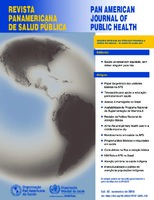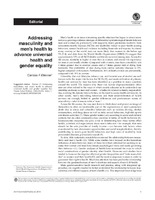Author: Etienne, Carissa F.
Source: Rev Panam Salud Publica;42, dec. 2018
Published online: 27 December 2018
Abstract:
 Men’s health as an issue warranting specific attention has begun to attract more notice as growing evidence emerges of differential epidemiological trends between men and women (1), particularly with respect to men’s premature mortality from noncommunicable diseases (NCDs) and morbidity linked to poor health-seeking behaviors, mental health and violence, including homicide and injuries.
Men’s health as an issue warranting specific attention has begun to attract more notice as growing evidence emerges of differential epidemiological trends between men and women (1), particularly with respect to men’s premature mortality from noncommunicable diseases (NCDs) and morbidity linked to poor health-seeking behaviors, mental health and violence, including homicide and injuries.
In almost every country of the world, men are more likely than women to die before age 70 (2–4), and data from the World Hea lth Organization (WHO) (5) suggest that approximately 52% of all NCD deaths worldwide occurred among men.
lth Organization (WHO) (5) suggest that approximately 52% of all NCD deaths worldwide occurred among men.
Across the life course, mortality is higher in men than in women, and overall life expectancy for men is universally shorter. Compared with women, men have a mortality rate 4 times greater due to external causes and a 7 times greater risk of dying from homicide. The probability of men dying from cardiac ischemic diseases is 75% higher compared with women. Furthermore, 36% of deaths in men are preventable, compared with 19% in women.
Full text: http://bit.ly/2AH35Oz
* The author/source alone is responsible for the views expressed in this article/publication or information resource, and they do not necessarily represent the positions, decisions or policies of the Pan American Health Organization. = El autor/fuente es el único responsable por las opiniones expresadas en este artículo/publicación o recurso de información y no necesariamente representan las posiciones, decisiones o políticas de la Organización Panamericana de la Salud.







